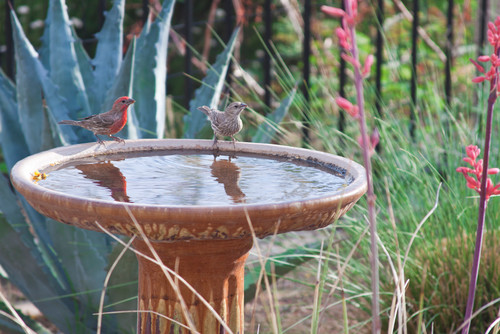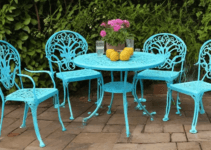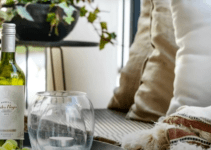Attracting and feeding birds in your backyard is one of the best ways to enjoy wildlife in the atmosphere and comfort of your home. More than that, you can feed and watch birds all year round. Be it summer, autumn, winter or spring, birds need food all year round and you will be amazed at the wide variety of wild birds that will come to the feeder throughout the whole year.

Photo by BOXHILL – Discover landscaping design inspiration
However, experts disagree if bird feeding will really help bird populations. But bird feeding will certainly help individual birds in your area.
Feeding wild birds in your backyard is not as difficult as you may think. Generally, you have to respect the first rule that says not to feed wild animals when it might cause harm, but when feeding birds there are only a few situations in which we can speak about harm being caused. Therefore, you can go ahead and start feeding and enjoying wild birds in your backyard.
Let’s see together some tips regarding this topic.
DO YOU NEED to FEED BIRDS ALL YEAR ROUND?
Generally speaking, it is not necessary nor advisable to feed birds all year round. Most wild birds do not need your seeds in the summer.
Usually, in the summer, it is the nesting time and they prefer to feed their young with insects. Therefore, feeding them is less necessary and however, it is more important for the young birds to learn how to catch insects.
The best time for feeding is when birds needs more energy, such as migration or during temperature extremes (late winter and early spring), when natural food sources are depleted.
However, there are two exceptions to this general rule, goldfinches and hummingbirds.
– Hummingbirds need your help (nectar in feeders) for their high metabolism.
– Goldfinches nest later than most of the birds and they need food such as Nyjer Seeds.
THE BEST PLACE for a BIRD-FEEDER
Wild birds like any other wild animal prefer to eat where they can feel safe from predators. Therefore, do not place the bird-feeder near a bush or in a tree.
The best is to place your feeder at least twelve feet from any bush or evergreen tree branch. Birds will feel safe because they can quickly fly in the event of danger.
More than that, as a further protection you can place thorny branches or chicken wire around and on ground level bird-feeders.
HOW to FEED BIRDS when YOU’RE OUT of TOWN
It is not a problem if you have to stop bird feeding briefly, when you are out of town. Birds fly and can easily find other bird-feeders in the area. However, you can ask a neighbor or a friend to maintain your feeder.
You Should Have these Decor Elements for Your Backyard (howtobuildahouseblog.com)
HOW to PROTECT BIRDS to COLLIDE with WINDOWS
Because windows are transparent and reflect the sky and the environment, can confuse birds and therefore, can be a real danger for them. They see a window as a clear flight path not as an obstruction and then, collision is inevitable.
You can prevent these kinds of accidents if you place your feeder away (at least 30 feet) from a window. That is a safe distance for birds from any confusing reflections. However, altering the appearance of your home windows can help, too. There are many ways to alter the appearance of your windows such as placing static-cling strike prevention decals that reflect a visible for birds, ultraviolet light or hanging streamers. Also, you can cover your window surface with a thin garden netting to prevent collision with the window surface.
BIRD FOOD SUGESTIONS
1| Winter Feeding:
– White Proso Millet that is very high in protein;
– Black Oil Sunflower Seed that is extremely high in fat;
– Peanuts; Nyjer Seeds; Suet Cakes; medium size Cracked Corn
2| Spring Feeding:
– Baked and crushed Egg-Shell for Calcium;
– Give them nesting materials such as: pet fur, human hair, cloth strips, bits of string, etc.
3| Summer Feeding:
– Nectar for hummingbirds and Nyjer Seed for goldfinches.
4| Autumn Feeding:
– White Proso Millet; Peanut Butter; Peanuts; Suet Cakes.
HUMAN FOODS are UNSAFE for BIRDS
You should not offer human foods to birds. Human foods are completely unhealthy and unsafe for them.
For example, bread has no real nutritional value for birds and it can even harm them. Also, chocolate is toxic for birds. They contain theobromine, which is an extremely toxic substance for birds.
Do not offer them table scraps that can attract rats or mice.
DIFFERENT FEEDERS at DIFFERENT LEVELS
Ground Level: Sparrows, Towhees, Juncos and Doves;
Table Level: Finches, Jays and Cardinals;
Hanging Feeders: Chickadees, Titmice and Goldfinches;
Tree Trunks: Wrens, nuthatches and Woodpeckers.
BIRD-FEEDER TYPES
There are many kinds of bird-feeders and it is quite difficult to choose the right one. However, you need to know that steel, glass or plastic feeders are easier to clean than wood or ceramic feeders because their non-porous surfaces.
Also, small feeders are easier to maintain than the big ones. They can be empty quickly and cleaned quickly.
Do not choose bird-feeders with sharp points or edges and choose a bird-feeder with drainage holes to keep seed dry.
Allow enough space between your feeders to prevent crowding.
YOUR WILDLIFE OASIS
Your backyard can be a wildlife sanctuary where you can enjoy unforgettable moments. With patience and passion, you can attract numerous species of birds.
You will enjoy seeing and hearing them. In fact, you can create a micro wildlife habitat, a sanctuary for these wonderful creatures.


